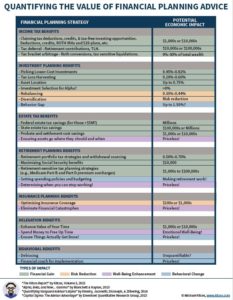Earlier this year, index fund assets surpassed actively-managed funds for the first time ever. Initially ridiculed and ignored when they were first introduced a few decades ago, index funds are now becoming mainstream.
It’s easy to see the appeal: broad diversification for a fraction of the cost of traditional mutual funds. And now we have several decades of track record showing what academics have known all along – index funds outperform the vast majority of their peers over the long run.
But there’s a group that, for the most part, refuses to accept that reality: financial advisors.
Financial Advisors Desperately Clinging to The Ways of the Past
A few months ago, I had a new client reach out to me noticeably flustered. She had recently been doing a lot of research on investing and came to believe that a buy-and-hold, low-cost portfolio of index funds was the way to go.
So why was she so troubled? Because when she approached her former advisor to inform him that she was transferring her accounts, he showed her a chart that seemed to contradict everything she had learned.
The chart showed that her account had drastically outperformed the S&P 500 index over the past year.
How was this possible?
Maybe this advisor was different. Maybe he could beat the market. Maybe this sort of skill was worth the high fees she was paying.
Not wanting to rush to any conclusions, I told her it was certainly possible he had outperformed the market – every year there are some who manage the feat.
However, upon further review I found, unsurprisingly, that she had actually underperformed the market, by a little more than the fee she was paying. The chart her advisor had shown her was not even her own performance, but the performance of some hypothetical portfolio.
Now, we could get into the ethics of her advisor and his attempts to mislead in order to keep her business. Maybe he’s just a bad apple. But after seeing this sort of behavior as many times as I have, I think there’s something more to it.
It’s very likely that this advisor was not just lying to his client, but that he was lying to himself.
Ignorance and Overconfidence
Every year, before fees, half of investors achieve above the market average and half achieve below average. Once you add on the average 1% mutual fund fee and 1% advisor fee, the number of individual investors that achieve market beating results drops to somewhere around 20-30% in a given year. Stretch that over a ten-year period, and the odds of outperforming the market is likely less than 5%.
My point here is that the odds of outperforming the market are incredibly small, and yet most financial advisors believe they can do it.
It reminds me of a study done by AAA that showed that 8 out of 10 men believe they are above-average drivers. Obviously only half of men can be better than average drivers. What 8 out of 10 men are is overconfident – and bad with probabilities.
Most advisors I know have seen the numbers and know that the odds of outperforming the market are incredibly slim. So why do they keep trying? Because they have convinced themselves that they are the exception.
You see, most financial advisors HAVE to believe that they can beat the market – even if all evidence points to the contrary.
Why?
Because beating the market is the simplest and most convincing reason they have for charging you 1% of your portfolio. Another story will illustrate what I mean.
Financial Advisors’ Fees Are Too High to Use Index Funds
Years ago, I was speaking with an advisor about the merits of a low-cost, buy-and-hold investment approach.
We looked at the overwhelming body of research that points to the low-odds of outperforming the market over the long run using stock-picking or market-timing strategies.
We then looked at the track record of a handful of this advisor’s top clients – many of whom he had been working with for more than 10 years. Up until this point, the portfolios were made up of various high-fee mutual funds – all of which attempted to outperform the market in one way or another. There were some that specialized in stock picking – trying to find the next Google or Amazon. Others attempted to time the market and avoid downturns like we experienced in 2008.
But despite all of the extra effort and complexity, ALL of the portfolios had under-performed a low-cost, index-fund approach. (Again, not a surprising result)
So, what was the advisor’s response when I asked if he planned to implement a buy-and-hold approach using low-cost funds?
“We can’t do that. Some of our clients pay $40,000 a year for our services. We can’t just invest in a handful of index funds and call it a day.”
Isn’t this situation backward?
The advisor charges the prevailing (though in my opinion long-outdated) fee of 1% to manage a portfolio. Then, in order to justify the fee, the advisor must make an attempt to beat the market, even though decades of research and his own personal track record indicate that he has almost no chance of succeeding.
So what’s the solution?
What we need are two drastic paradigm shifts in financial planning:
- The value proposition that advisors promote to the public must change
- The way advisors charge for their services must change to support the value being delivered
The True Value of a Financial Advisor
If a financial advisor can’t beat the market – can’t do better than low-cost index funds – then why do you need a financial advisor anyway?
You would think Vanguard, one of the pioneers of the index fund, would be a critic of financial advisors. “Just buy our index funds and you’re set.” But this couldn’t be farther from the truth. In fact, Vanguard has promoted a concept they call “Advisor’s Alpha” which seeks to measure the value a financial advisor can add to your portfolio, outside of market timing and stock picking. These value-adds include things like asset location (discussed here), tax-efficient withdrawal strategies, and behavioral coaching (AKA helping clients avoid selling when the market crashes).
They’re estimate of total value added? About 3%. Why play a high-cost losing game of trying to beat the market when a good advisor can add 3% of value just in careful planning advice?
Similarly, Michael Kitces, an industry thought leader, has attempted to quantify the true value of a financial advisor – which has little to do with beating the market.

While many advisors see index funds as competition and a threat to the value they offer clients, the reality is that index investing has provided enormous benefits to investors by allowing them to achieve broadly diversified portfolios at minimal costs. This evolution should be embraced by advisors, not shunned.
Using index funds to design a portfolio doesn’t diminish the value a financial advisor can provide, it enhances it.
If your advisor focuses all of his attention on portfolio performance and trying to beat the market, you can be fairly certain you are paying too much for advice and you are likely to be disappointed with the results.
The new paradigm of financial advice focuses on capturing market returns in an efficient way using low-cost index funds and adds value through the careful planning outlined by Vanguard and Kitces.
A New Fee Model for Delivering Financial Advice
You may be wondering why more financial advisors haven’t yet embraced index funds and this new paradigm of financial planning.
Upton Sinclair probably said it best:
“It is difficult to get a man to understand something, when his salary depends on his not understanding it.”
What I realized many years ago in my conversation with my advisor friend is that it will be incredibly difficult for the financial services industry to embrace this new paradigm unless they first change their business models.
As my friend said, you can’t charge $40,000 a year for a simple (yet efficient) portfolio of index funds. You have to put on a big show about how you’re doing lots of complicated and sophisticated things that will maybe… hopefully… fingers-crossed… beat the market.
The typical fee structure of charging around 1% of client portfolios had to go.
Instead of arbitrarily tying the fee to the size of a client account, the new paradigm calls for a fee structure more common in other professions – a fee that compensates the professional for their time and expertise. This flat fee structure can be an hourly rate, a fixed fee per project, or an annual retainer structure.
What these fee structures all have in common is that they truly put the advisor on the same side of the table as the client.
If the right solution is a simpler one – like using a buy-and-hold approach, rather than one that involves constant monitoring and frequent trades – then the advisor can charge a fee that aligns with that solution and service model.
Index Funds and SwitchPoint
SwitchPoint was built on these principles. We don’t charge the standard 1% fee and then try to justify it by overly complicating portfolios. Instead, we’ve embraced the research on investing that points to low-costs, diversification and discipline. And we’ve designed our flat fee structure to fairly compensate us for the services we provide.
If you’d like to learn more about how index funds can lower your fees and improve your long-term returns, you can schedule a complimentary, no-obligation introduction. Just click here.

